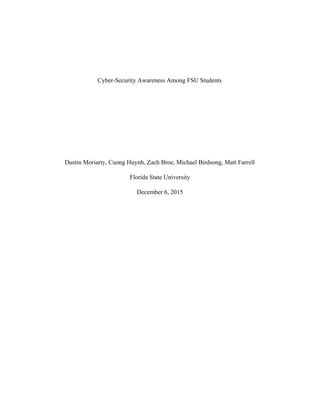
team2_FinalPaper.docx
- 20. CyberSecurity Awareness Among FSU Students 19 omic%20Scientists&stitle=Bull.At.Sci.&date=2013&volume=69&pages=1520&issue=5&atitle =Eyes%20wide%20shut%3A%20The%20growing%20threat%20of%20cyber%20attacks%20on %20industrial%20control%20systems&spage=15&au=Brenner%2CJoel%20F.%20& Cisco Systems Inc. (2010). Cybersecurity: Everyone’s Responsibility retrieved from: http://www.cisco.com/web/strategy/docs/education/C4562682500_Cyber_Security_Responsibi lity_AAG.pdf Madden, C., Mary, B., Rainee, A., Lee, H. (2015) Americans’ Attitudes About Privacy, Security and Surveillance Pew Research Center retrieved from: http://www.pewinternet.org/2015/05/20/americansattitudesaboutprivacysecurityandsurveilla nce/ Instructions for Final Report (150 points) ● In the final report, you must revise the first drafts that you wrote in previous assignments through semester based on the feedback given by the instructor and create a report document. The final report should include the contents listed below: ○ Title page (project title, team member names, etc.) ○ Abstract (less than 300 words) ○ Introduction ■ Problem statement ■ Significance and purpose of the study ■ RQs ○ Literature review (not Annotated Bibliography!) 1 of 3 done
- 21. CyberSecurity Awareness Among FSU Students 20 ■ Organize 2 4 sub sections regarding problem and significance (meaning structure of your literature review). ■ Provide your own synthesis under the sub section titles based on your interpretation of articles you read and summarized on your AB work. ○ Methods ■ Data collection method(s) ■ Summary of research instrument development process ■ Research population, sample, and sampling technique(s) ■ Recruitment strategy and process ○ Analysis (Findings/Results) ■ Start with the descriptive analysis (information about your subjects based on mean, median, and mode). ■ Provide your findings (no interpretation yet!) under each RQ or theme you want to address. ■ Organize your quantitative (e.g., texts, tables, charts, graphs) and qualitative findings (e.g., texts, themes, direct quotes) with visuals. ○ Discussions/Implications Needs more ■ Briefly state the findings again and provide your interpretation and meaning of findings. ■ You can validate your findings by comparing/contrasting with previous studies. ■ Provide significance of the findings. ○ Limitations/Further Study ■ Do not color/hide your design or findings. ■ List them and plan for the future study. ○ Conclusions ■ Briefly conclude the findings and significance once again.
- 22. CyberSecurity Awareness Among FSU Students 21 ○ Reflections on your research experience ■ What you learned, what challenges and issues you faced, how you handled and managed them, etc. ● The report should be a professional document based on APA style, having a title page, page numbers, and references. A simple collection of each assignment will NOT be considered as a professional report. ● Highlight your updates from the original assignments (use yellow highlight in WORD), to show how you made an improvement on the documents. ● File naming rule: ○ team#_Final Paper.doc(x)